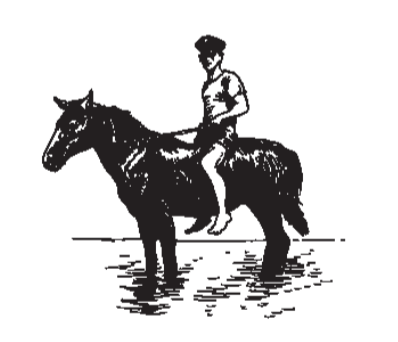Someone who knows more about books than I do told me to read How German Is It (1979) by Walter Abish. I had never heard of it, but I immediately wanted it. What a title! I rushed right out—at lunch—and bought it. The cover featured a black-and-white photograph of a man on a horse. This same photograph is described in the novel itself: “a horse standing in a lake, in one or two feet of water, with its muscular erect bareback rider wearing a visored military cap and looking into the camera’s lens.”
How German is that? Not very, at first glance. But the military hat does, inevitably, connote the Third Reich, and a rider’s bare legs against a horse’s wet hide might be an image from a German health magazine. These are just generalizations—but what I admired about the cover of How German Is It, and its title in particular, was its seeming willingness to play with stereotypes. The book, I expected, would be either a conceptual parody, or a high-camp travelogue.
*
In his recent memoir, Double Vision (2004), Abish mentions how friends have taken frequent pains to introduce him to real Germans since the publication of How German Is It. “When I entered the Helmsley Palace Hotel, where [Werner and I] were to meet, I saw the man I took to be Werner, monklike in a voluminous forest-green loden coat, pacing the empty lobby.” This Werner has just read Abish’s novel and is exasperated— “Alone, the incorrectly spelled German words!” he exclaims.
Werner is especially suspicious of the novel’s closing scene, in which the protagonist, Ulrich, visits a hypnotist. Eyes closed, he raises his right hand in what resembles a Nazi salute but is actually, Abish tells Werner, “a routine test by means of which a hypnotist determines his subject’s susceptibility to hypnotism.” Given the context, this gesture has a double meaning, an ambiguity that drives Werner crazy. Abish explains, “I intended How German Is It to elicit a multiple, if indeterminate, response. I was inviting the reader to bring his or her accumulated German material, his or her particular version of Germany, to the text, for is there anyone outside of Germany who doesn’t hold a decided view of Germanness?”
Abish’s explanation might be read as an excuse, a piece of sophistry that diffuses his tart indictment of the German soul. But he makes an inarguable assertion: everyone has a decided view of Germanness, even those who have never visited Germany.
Abish himself had never been to Germany when he wrote How German Is It. In Double Vision, he tells...
You have reached your article limit
Sign up for a digital subscription and continue reading all new issues, plus our entire archives, for just $1.50/month.
Already a subscriber? Sign in





